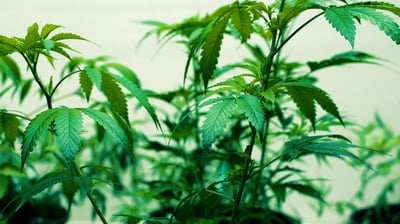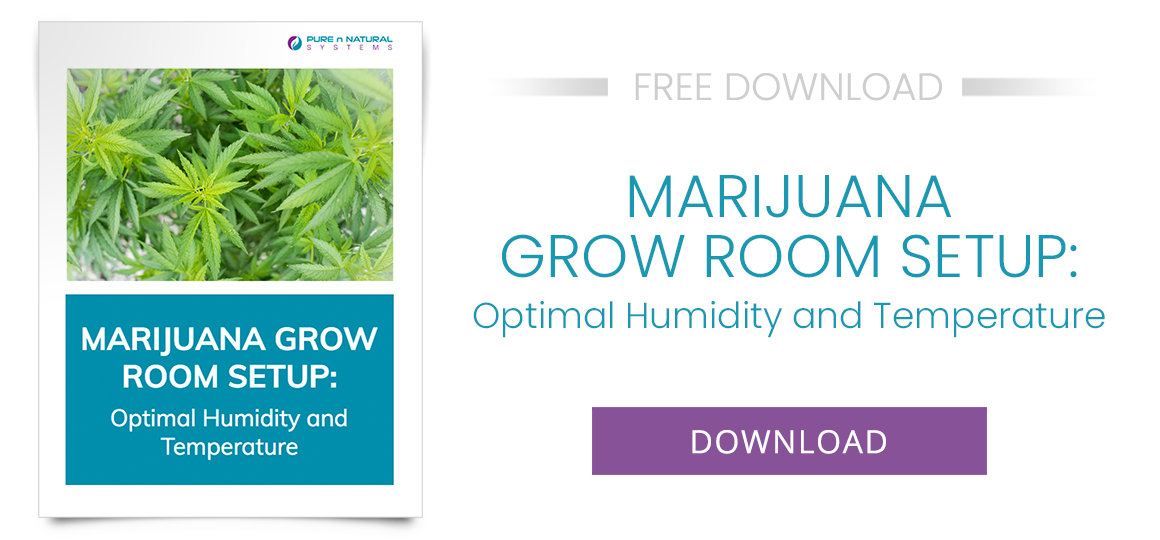 As a grower, it may feel like you’re constantly battling to get the humidity down to protect your fattening buds from powdery mildew and botrytis. But don’t forget about the needs of your seedlings or cuttings. They need nearly double the humidity levels of their flowering counterparts.
As a grower, it may feel like you’re constantly battling to get the humidity down to protect your fattening buds from powdery mildew and botrytis. But don’t forget about the needs of your seedlings or cuttings. They need nearly double the humidity levels of their flowering counterparts.
Plants at different growth stages have completely different humidity needs. For the first four weeks or so, young plants need upwards of 65-70% humidity for vigorous growth. This extra humidity is needed because root systems have not fully developed yet, so most of their water is absorbed through the leaves.
Too little humidity during this stage will stunt a young plant’s growth meaning lower yields in the long run. To protect your future crops, it’s important to invest in a humidifier or series of humidifiers depending on your setup and budget to get everything started on the right foot.
Understanding Humidifier Types & Uses
There are many different types of humidifiers out there and few are designed with commercial-sized growing operations in mind. Generally, there are five humidifier types available. Let’s take a look at the various types to get a better idea of what you’ll want for your specific build.
Ultrasonic Humidifier
Widely regarded as the “best option,” it can produce both warm and cool mists allowing for an added temperature control in addition to its humidity controls. Remember, temperature and humidity goes hand-in-hand, with warmer temperatures allowing for higher relative humidity levels.
With the warm mist settings, water is heated internally before release. This mist then enters the air and evaporates to increase the relative humidity. With cool mist settings, water is evaporated by means of ultrasonic vibration. An internal fan pushes the mist out into the room while also keeping the humidifier from overheating.
Advantages:
- Very quiet
- No need for frequent filter changing
- Easy to maintain
- Excellent environment controls
- Can both raise or lower temperatures on demand while increasing humidity
Disadvantages:
- Cannot connect to tap water source
- Generally higher price
Cool Mist Humidifier
This type of humidifier releases cool mists by drawing the air from the room and blowing it over the moistened water. This process increases the humidity and removes the heat from the air. For this reason, it is called a cool mist humidifier.
Advantages:
- Easy to clean
- Very efficient for large spaces
- Suited for warmer external air conditions where cooling might be needed
- Simple to operate
Disadvantages:
- Rather noisy when operating
- Higher maintenance cost
- Bacteria or contaminants in the water tray aren’t sterilized before the mist is released
- Filters need to be changed regularly
Warm Mist Humidifier
This is the most common type of humidifier you’ll find on the market. It heats water internally and then releases it as a mist into the room. When your external air is a little cooler than you’d like, this can have the added benefit of slightly raising temperatures in your tent while providing the much-need humidity.
Advantages:
- Reasonably priced
- Quieter than cool mist humidifiers
- Heated water will kill bacteria present in the water before releasing into the room
- Relatively easy to run
Disadvantages:
- Can be difficult to clean
- Limited in range to small spaces
- Uses more electricity
- Needs regular maintenance
Evaporative Humidifier
This type of humidifier operates much like hanging a wet towel in front of a fan with the added benefit of a built-in hygrometer to tell the fan when to stop blowing. Relative temperature won’t be drastically affected so this type is best in rooms where the temperature is consistently well regulated and only relative humidity increases are being targeted.
Advantages:
- One of the cheapest humidifier options available
- Filters remove bacteria and other contaminants
- Relatively easy machine maintenance
Disadvantages:
- Requires regular cleaning
- Frequent filter changes
Air Washer Humidifier
One of the more advanced options, it both adds humidity while removing airborne particles like dust and pollen. They are only available with cool mist release at this time.
Advantages:
- Low noise when running
- Covers larger areas
- Easy to operate
Disadvantages:
- Can become clogged from dust in the water
- Regular maintenance is required
- Generally higher price
Choosing the Best Humidifier for Your Grow Room
Important factors to consider when deciding what will work best for you are: room size, external air temperature, and humidity throughout the year (since you’ll be introducing that air into the room when ventilating), how much maintenance you can or want to do and budget.
Room Size
Here’s a quick reference chart to get a basic understanding of how much area the relative size of a humidifier can handle.
Small humidifiers - 300 square feet
Medium humidifiers - 350-500 square feet
Large humidifiers - 550-1000 square feet
Cool Mist vs. Warm Mist
This decision will be mostly decided by the outdoor environment. As you’ll need to pump outdoor air in to keep a steady flow of fresh air, you’ll want to consider the annual climates of where you’re growing. If it’s always hot and dry, you’ll want a cool-mist humidifier. Conversely, if it’s cold year-round, you’ll want a warm mist solution. For most growing regions, it isn’t so cut and dry which is why ultrasonic humidifiers are generally regarded as the best option in most rooms.
Mineral Dust
You’ll want to decide what type of mineral dust you’ll use in your humidifier. If it’s too dusty or contains too many microorganisms, you’ll find it best to use an evaporative humidifier. It’ll remove these contaminants before evaporation and release. If you don’t face this issue, any of the other humidifier options are probably more desirable.
Automation vs. Manual Inputs
If you enjoy the peace of mind that comes with entering settings and then letting the humidifier do its job without constant management, then you should definitely consider either an ultrasonic humidifier or an air washer humidifier. They have the most automated features of available options with the least amount of micromanagement on your end. However, if the budget doesn’t allow it, or you just prefer to be hands-on, cool mist, warm mist or evaporative humidifiers are all viable options.
Cleaning and Maintenance
It’s always a good idea to choose an option with the least amount of maintenance needed as maintenance increases workload and overall cost. This is one of the least considerations though since environmental needs will outweigh maintenance wants. The humidifier types with the least amount of cleaning maintenance are ultrasonic and cold mist humidifiers.
Noise Levels
All humidifiers make noise. Some are just far noisier than others. The least noisy options are ultrasonic and evaporative humidifiers, followed by warm mist and cold mist humidifiers.
Budget
It goes without saying that the best option is the one you can afford. Just remember, more automation means more cost.
If you're looking for a comprehensive resource on growing your crops beyond humidifiers, check out our online guide, Marijuana Grow Room Setup: Optimal Humidity and Temperature.



![4 Ways Indoor Humidity Can Cause Problems For Your Business [2025 UPDATED]](https://blog.purennatural.com/hubfs/a%20factory%20with%20extreme%20humidity%2c%20showing%20condensation%2c%20heavy%20air%2c%20and%20workers%20struggling%20with%20the%20damp%20environment.webp)

